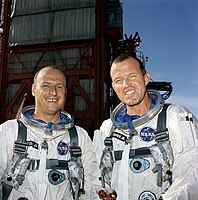Gemini 5
| Mission emblem | |||
|---|---|---|---|

|
|||
| Mission dates | |||
| Mission: | Gemini 5 | ||
| COSPAR-ID : | 1965-068A | ||
| Spacecraft: | Gemini 5 | ||
| Launcher: | Titan II Gemini 62-12560 | ||
| Crew: | 2 | ||
| Begin: | August 21, 1965, 14:00:00 UTC | ||
| Starting place: | LC-19 , Cape Canaveral | ||
| Landing: | August 29, 1965, 12:55:14 UTC | ||
| Landing place: |
Atlantic 29 ° 44 ′ N , 69 ° 45 ′ W |
||
| Flight duration: | 7d 22h 55min 14s | ||
| Earth orbits: | 120 | ||
| Recovery ship: | USS Lake Champlain | ||
| Orbit inclination : | 32.61 ° | ||
| Apogee : | 350.1 km | ||
| Perigee : | 162 km | ||
| Covered track: | 5,242,682 km | ||
| Team photo | |||
 from left Charles Conrad and Gordon Cooper |
|||
| ◄ Before / After ► | |||
|
|||
Gemini 5 (GT-5) was a manned space flight under the US Gemini program .
The team
Even before the first manned Gemini spacecraft took off, NASA announced the crew of the third manned Gemini flight on February 8, 1965. Gordon Cooper was nominated as commander, making him the first person to go into orbit a second time after his Mercury Atlas 9 flight. Charles Conrad , a space newcomer from the second astronaut selection group, was assigned as co-pilot .
The replacement team consisted of Neil Armstrong and Elliot See , both of whom had no previous space experience.
Liaison spokesman ( Capcom ) in Cape Kennedy was Virgil Grissom , the commander of Gemini 3 . From Houston , now the Lyndon B. Johnson Space Center , James McDivitt , who was in command of Gemini 4 , Neil Armstrong and Edwin Aldrin kept the connection.
preparation
The flight of Gemini 5 was designed for eight days, twice as long as the previous flight of Gemini 4. The aim of Gemini 5 was to demonstrate the reliability of all systems for such a duration, and to study the influence of weightlessness on the astronauts .
For the first time, the energy supply should come not only from batteries , but also from fuel cells , and it was also planned to carry out rendezvous maneuvers with a target satellite, which Gemini 5 was to deploy itself.
There would be no outboard operation like the Gemini 4. Outboard activities of this kind were only planned for Gemini 8 again .
Gemini 5 was the first NASA flight to use its own badge. Cooper came up with a proposal for a covered wagon. The proposal was accepted, but the motto Eight days or bust (for example: eight days or bankruptcy ) was rejected. For NASA Director James E. Webb , it would not mean bankruptcy if the mission did not last the planned eight days. In fact, at the end of the flight, there was an hour missing from the full eight days.
The mission badges of the Mercury flights and those of the Gemini 3 and Gemini 4 were designed long after the flights.
Flight history
The start was initially scheduled for August 19, 1965, but the countdown had to be interrupted 10 minutes before take-off due to a computer problem. As a storm was approaching, the start was canceled and postponed for two days.
Gemini 5 then took off on August 21, 1965. After just two hours, Cooper and Conrad put the target satellite out, but shortly thereafter there was a pressure drop in the fuel cells, which forced the astronauts to shut down some systems and made the rendezvous maneuver impossible.
For a short time even aborting the flight was considered. However, when the pressure stabilized and tests on the ground showed that it was also possible to work with this low pressure, the systems were gradually switched on again and the mission continued.
On the third day, rendezvous maneuvers were flown with a fictitious target satellite. Precise orbit changes of this kind were new to space travel, but were successfully completed. After a few days, several control nozzles failed, so that further tests were not carried out.
Due to bad weather in the target area, the landing was brought forward by one radius. Due to incorrect data in the computer, the landing point was missed by 145 km. However, since several ships were involved in the rescue, Cooper and Conrad were secured by divers on the USS DuPont and brought to the main ship USS Lake Champlain in a helicopter .
Importance within the Gemini program
With eight days, the crew set a new long-term record in space, with which the USA took the lead over the Soviet Union in this area . This also proved that people can live in weightlessness for a longer period of time than is necessary for a moon flight.
However, the flight also showed some weaknesses with the fuel cells.
The next Gemini 6 flight was scheduled for October. For the first time, a spaceship was supposed to couple with an unmanned target satellite that was specially launched.
See also
Web links
- Gemini 5 in the NSSDCA Master Catalog (English)
- NASA: Gemini 5 mission summary (English)
- Radio communication protocols (PDF, English)


